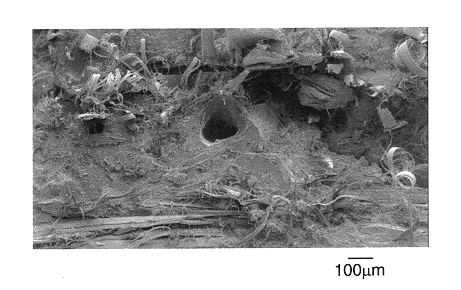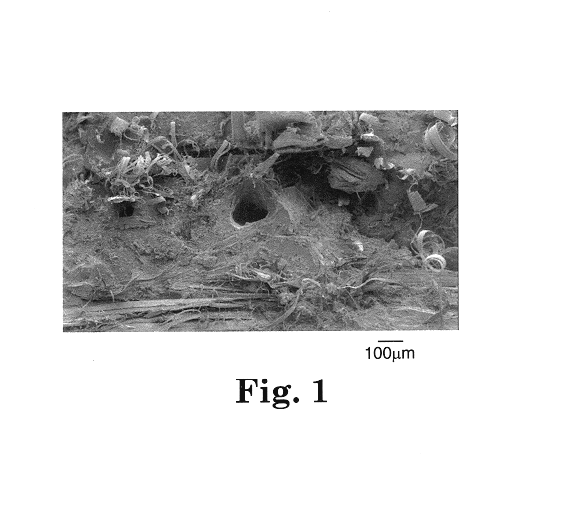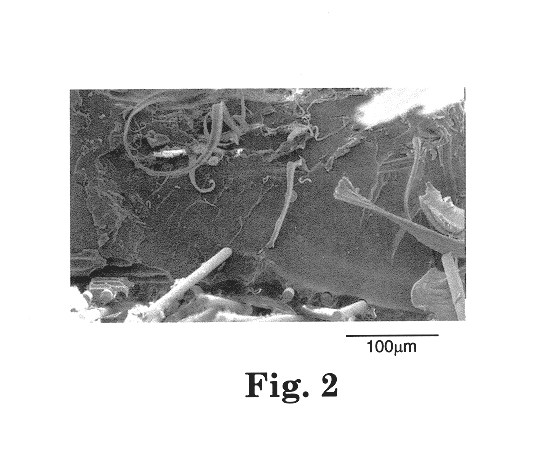Composite articles reinforced with highly oriented microfibers
a technology of high-oriented microfibers and composite articles, applied in the field of composite materials, can solve the problems of composite articles with a relatively brittle matrix, many materials, such as metals, have the disadvantage of relatively high weight and density, and are unsuitable for marine applications, so as to increase the toughness of composite articles and add strength and stiffness to the elastomeric matrix material
- Summary
- Abstract
- Description
- Claims
- Application Information
AI Technical Summary
Benefits of technology
Problems solved by technology
Method used
Image
Examples
examples 1-2
(Reinforced Elastomeric Polypropylene) and Comparative Example C1
Samples of semi-syndiotactic polypropylene were pressed into films ranging in thickness from 50.8 to 501 microns, using a Model C Carver Laboratory Press (Fred Carver Inc., Wabash, Ind.) with a 15.2.times.15.2 cm heated platten. The applied load was 6.895 Mpa, and the platten temperature either 121.degree. C. or 177.degree. C.
A microfibrillated web made by microfibrillating highly oriented polypropylene as described in Example 1 of U.S. Pat. No. 6,110,588 was sandwiched between two semi-syndiotactic polypropylene films having a thickness of 0.18 to 0.25 mm and pressed at 6.895 Mpa with the platen temperature at 121.degree. C. to a thickness of 0.30 to 0.38 mm. Visual inspection of the resulting reinforced syndiotactic polypropyene composite sheet revealed that complete wetting of the microfiber bundles was not achieved. Samples having a width of 0.635 cm and a length of about 7.6 cm were cut from the composite sheet, s...
examples 3-5
Comparative Example C2 (Microfiber Reinforced Thermoset Epoxy)
Microfiber reinforced thermoset samples were made using 1, 4 and 8 layers of cross-lapped microfibrillated web made by microfibrillating highly oriented polypropylene essentially as described in Example 1 of U.S. Pat. No. 6,110,588. The microfiber reinforcement web was measured to have a surface area of approximately 3.5 square meters per gram and a density of 0.10 g / cc. The microvoided highly oriented polypropylene film prior to fibrillation had a density of 0.7 g / cc.
ERL 4221 (a cycloaliphatic epoxy with a viscosity at room temperature of 400 cp, obtained from Union Carbide, Danbury, Conn.) was compounded with 2% by weight of triarylsulfonium hexafluoroantimonate (cationic catalyst R-23164, CAS#57840-38-7, in powder form, available from 3M, St. Paul, Minn.) in a stirred jacketed vessel at 100.degree. C. for fifteen minutes. The resulting catalyzed epoxy resin was poured over the microfibrillated web (10 cm.times.10 cm), ...
example 6-8
Comparative Example C3 (Microfiber Reinforced Thermoset Epoxy / Polyol)
Microfiber reinforced thermoset samples were made using one layer of 5.1 cm.times.5.1 cm squares of microfibrillated web (made by microfibrillating highly oriented polypropylene essentially as described in Example 1 of U.S. Pat. No. 6,110,588) with various amounts of thermoset resin. An epoxy / polyol thermoset resin was prepared essentially as in Example 3 by combining ERL 4221.TM. at 80% by weight with Tone 0201.TM. (a difunctional polycaprolactone polyol from Union Carbide) at 20% by weight. Triarylsulfonium hexafluoroantimonate (CD1010, a cationic photoinitiator, from Sartomer, Exton, Pa.), was used at 2% by weight. The microfiber reinforcement square was placed on release PET liner with silicone release. The epoxy / polyol composition was poured onto the mat and release liner was placed on top and then a roller was used to spread out the resin and wet the microfibers. A Model C Carver laboratory press was heated t...
PUM
| Property | Measurement | Unit |
|---|---|---|
| effective diameter | aaaaa | aaaaa |
| cross-sectional area | aaaaa | aaaaa |
| cross-sectional area | aaaaa | aaaaa |
Abstract
Description
Claims
Application Information
 Login to View More
Login to View More - R&D
- Intellectual Property
- Life Sciences
- Materials
- Tech Scout
- Unparalleled Data Quality
- Higher Quality Content
- 60% Fewer Hallucinations
Browse by: Latest US Patents, China's latest patents, Technical Efficacy Thesaurus, Application Domain, Technology Topic, Popular Technical Reports.
© 2025 PatSnap. All rights reserved.Legal|Privacy policy|Modern Slavery Act Transparency Statement|Sitemap|About US| Contact US: help@patsnap.com



